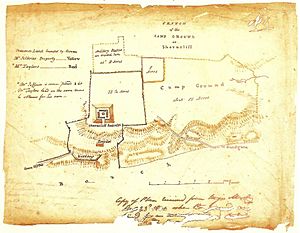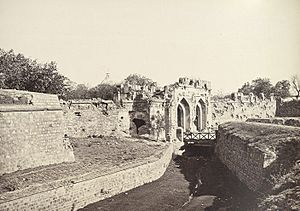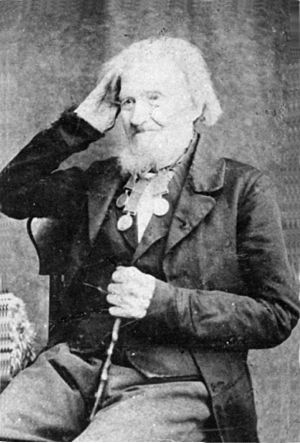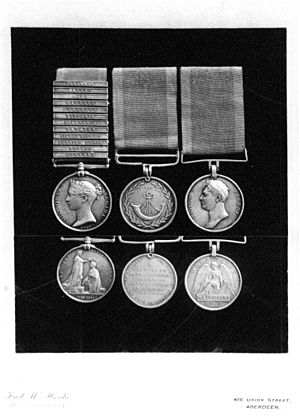52nd (Oxfordshire) Regiment of Foot facts for kids
Quick facts for kids 52nd (Oxfordshire) Regiment of Foot |
|
|---|---|
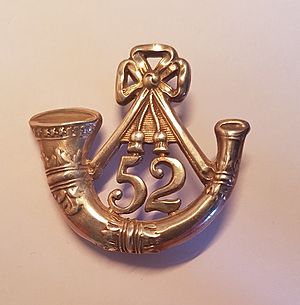
Cap badge of the 52nd (Oxfordshire) Regiment of Foot
|
|
| Active | 1755–1881 |
| Country | |
| Branch | |
| Type | Line infantry |
| Role | Light infantry |
| Size | One battalion (two battalions 1799–1803; 1804–1815) |
| Garrison/HQ | Cowley Barracks, Oxford |
| Nickname(s) | "The Light Bobs" |
| Colours | Buff and scarlet |
| March | "Lower Castle Yard" |
| Engagements | American Revolutionary War (1775–1778) including: Lexington and Concord; Bunker Hill; Siege of Boston; Long Island; White Plains; Occupation of Newport, Rhode Island; Fort Washington; Princeton; Brandywine; Philadelphia campaign; Fort Montgomery Second & Third Anglo-Mysore Wars (1783–1793) including: Cannanore; Bangalore; Seringapatam (1792) French Revolutionary Wars (1793–1801) including: Pondicherry, Ceylon, Quiberon, Cadiz, Ferrol Copenhagen (1807) Peninsular War (1808–1814) including: Vimeiro; Corunna; Côa; Bussaco; Casal Novo; Sabugal; Fuentes de Oñoro; Ciudad Rodrigo; Badajoz (1812); Salamanca; Vitoria; Pyrenees; San Marcial; Bidassoa; Nivelle; Nive; Orthez; Tarbes; Toulouse Walcheren Campaign (1809) Holland (1813–14) Waterloo (1815) Indian Mutiny (1857–8) |
| Commanders | |
| Notable commanders |
Sir John Clavering (1762–1778) Cyrus Trapaud (1778–1801) Sir John Moore (1801–1809) Sir John Colborne (1811–15) |
The 52nd (Oxfordshire) Regiment of Foot was a famous light infantry regiment in the British Army. It served for over 100 years, from 1755 to 1881. This regiment was known for its bravery and skill in many wars. One famous historian, Sir William Napier, said they were "a regiment never surpassed in arms".
The 52nd first fought in the American War of Independence. Later, they were sent to India for the Anglo-Mysore Wars. During the Napoleonic Wars, they were part of the special Light Division. They fought in almost every major battle of the Peninsular War. At the Battle of Waterloo in 1815, they were the largest British battalion. They even helped lead the final charge against Napoleon's best soldiers, the Imperial Guard.
The regiment started as a regular infantry unit in 1755. It was first called the "54th Foot" but changed to the "52nd Regiment of Foot" in 1757. In 1781, it got the name "52nd (Oxfordshire) Regiment of Foot". Then, in 1803, it became a "Light Infantry" regiment. In 1881, the 52nd joined with the 43rd (Monmouthshire) Regiment of Foot. This new unit later became the Oxfordshire and Buckinghamshire Light Infantry.
Contents
What Was the 52nd Regiment?
A "regiment" is a large group of soldiers in an army. The 52nd was an infantry regiment, meaning its soldiers fought on foot.
How Regiments Were Organized
British Army regiments had different parts. They usually had at least one battalion, which is a main fighting unit. Sometimes, like the 52nd, they had two battalions. Each battalion was led by a lieutenant colonel.
A battalion was made up of ten companies. Eight were "centre" companies, and two were "flank companies". Flank companies included grenadiers (soldiers who threw grenades) and specialist light infantry. Each company was led by a captain, with lieutenants and ensigns (junior officers) helping him.
Ideally, a battalion had 1,000 soldiers. If the first battalion needed more soldiers, they would take fit recruits from the second battalion. This meant the second battalion might be weaker. If a battalion lost too many soldiers, it might be temporarily joined with another regiment.
The 52nd started with one battalion. But in 1798, they created a second battalion because they had so many new recruits. The first battalion fought in Spain and Portugal. The second battalion stayed in England. In 1803, the best soldiers from the 52nd were put into the first battalion to train as light infantry. The second battalion was then moved to the 96th Foot.
A new second battalion for the 52nd was created in 1804. Both battalions fought a lot during the Napoleonic Wars. They even fought together for a while. But after heavy losses in 1812, the second battalion became very small. It was later rebuilt with new recruits and served in Holland. After the war ended in 1814, the second battalion's soldiers joined the first battalion. The 2nd/52nd (second battalion of the 52nd) was then disbanded in 1815. After that, the 52nd remained a one-battalion regiment until it merged with the 43rd.
What is Light Infantry?
The 52nd started as a regular "line regiment." This meant they fought in tight lines, firing together. But in 1803, they became a "light infantry" regiment.
Before this, the British Army sometimes used special light infantry soldiers or hired them from other countries. Regular regiments were supposed to have one light infantry company from 1758. But their training was not always good.
The Duke of York realized Britain needed better light infantry. This was especially true when fighting against Napoleon's skilled French light infantry, called chasseurs.
In 1801, a new group called the "Experimental Corps of Riflemen" was formed (later the 95th Rifles). Then, a decision was made to train some regular line regiments in light infantry skills. This way, they could fight as both light and line infantry. Sir John Moore, who believed in light infantry, suggested his own regiment, the 52nd, get this training. They trained at Shorncliffe Camp. The 43rd Foot soon followed. These two regiments fought many battles together as part of the famous Light Division.
Moore wrote that the 52nd's soldiers knew exactly what to do. He said their discipline was good without being too harsh. Officers and soldiers were close. This was because light infantry officers trained with their men. Soldiers also learned to think for themselves. When fighting in small groups, they often had to react without direct orders.
Since light infantry worked in small groups ahead of the main army, they used special bugle calls to get orders. Because of this, the bugle became the symbol of light infantry regiments.
When fighting in small groups, light infantry soldiers often fought in pairs. One soldier would fire while the other reloaded. Unlike line regiments, who fired all at once, light infantry fired when ready, aiming carefully. Most light infantry used standard muskets, not rifles, because rifles were hard to get.
Light infantry soldiers wore lighter gear than regular soldiers. They could march faster, at 140 steps per minute. Their jobs included:
- Being the advance guard (first group) or rear guard (last group) for armies.
- Protecting the sides of the army.
- Fighting in small groups ahead of the main line.
They also sometimes had to fight in regular line formations or help storm enemy forts. During the Peninsular War, they were seen as the army's best soldiers.
The 52nd Regiment's History
Early Years and America
The 52nd Regiment started in 1755. It was first called the 54th Foot, then the 52nd Foot in 1757. For a while, they were stationed in England and Ireland. In 1765, the regiment moved to Canada. On the way, their ship ran aground, but everyone got off safely.
Twenty years after it was formed, the 52nd fought in the American War of Independence from 1774 to 1778. They were sent from Canada to Boston. They fought in the battles of Lexington and Bunker Hill in 1775. At Bunker Hill, the 52nd fought alongside the 43rd Foot for the first time. They lost many soldiers there. In 1778, the remaining soldiers joined other regiments, and the officers went back to England. The regiment got new recruits, and in 1782, it was given the county name "Oxfordshire".
Wars in India
In 1783, the 52nd arrived in Madras, India. They spent nine years fighting in the Second and Third Anglo-Mysore Wars. These wars were against Tipu Sultan, the ruler of Mysore.
In 1785, a part of the 52nd helped attack Cannanore. The 52nd stormed the walls there. In 1791, the regiment fought at Bangalore and Arakere. In December 1791, soldiers from the 52nd and 76th Foot led the attack on Savandroog. The enemy left the fort, and it was taken with only one British soldier wounded. The 52nd's band played music during the attack to encourage the soldiers.
The 52nd was also at the siege of Seringapatam in 1792. During this battle, the 52nd helped Lord Cornwallis when his soldiers were in danger. Tipu Sultan then asked for peace. In 1793, the regiment also helped attack Pondicherry.
French Revolutionary Wars
In 1793, war started with France. The 52nd went to Ceylon (now Sri Lanka) in 1795 and helped capture it from the Dutch. The 52nd returned to Britain in 1798. A second battalion was created then. In 1800, the 1st/52nd (first battalion) took part in expeditions to places like Quiberon and Ferrol. They returned to England in 1801.
In 1803, the 1st battalion became a "corps of light infantry". They started training under Major-General John Moore at Shorncliffe Camp. They formed a brigade with the 95th Rifles. A new second battalion was raised in 1804.
Napoleonic Wars
Both battalions of the 52nd fought in the Napoleonic Wars. In 1806–07, the 1st battalion was in Sicily. In August 1806, the 2nd battalion went to Copenhagen and helped attack the city in 1807.
In August 1808, the 2nd/52nd landed in Portugal. They were the first to meet the enemy at the Battle of Vimeiro. After this battle, Sir John Moore, the 52nd's colonel, took command of the British troops.
In October, Sir John Moore led the army into Spain. In December, the 1st/52nd joined them. Moore's army had 25,000 soldiers. But Napoleon had a huge army of 200,000. Moore had to retreat to Corunna. The 1st/52nd helped protect the army's rear during this difficult retreat. They fought well, even when other regiments struggled. In January 1809, the army was caught by the French at Corunna. During the battle, Moore was killed. The army, including the 1st/52nd, was evacuated to England.
Wellesley's Peninsular Campaign
The 1st/52nd returned to Portugal in June 1809. They were called the "Light Brigade". They marched very fast to reach the Battle of Talavera, arriving just after it ended. They covered 42 miles in 26 hours, which was amazing for infantry. From then on, the 1st/52nd often marched ahead of the main army.
In 1810, Portuguese soldiers joined the Light Brigade, creating the Light Division. The Light Division fought in the Battle of the Côa and the Battle of Bussaco. At Bussaco, they held their ground against a main French attack, causing many French casualties. When Wellington's army retreated to the Lines of Torres Vedras, the Light Division protected the rear. They also fought in skirmishes at Casal Novo and Sabugal in 1811. Wellington later called the fight at Sabugal "the most glorious that British troops were ever engaged in."
The 2nd/52nd, after being in the Netherlands, returned to Portugal in 1811. They joined their first battalion. In May, both battalions fought at Fuentes de Oñoro.
In January 1812, the army attacked Ciudad Rodrigo. Soldiers from the Light Division, led by the 52nd's Colonel Colborne, captured a fort. On January 19, a big attack was planned. Lieutenant John Gurwood of the 52nd led the "Forlorn Hope" (the first, most dangerous group). The fort was taken quickly, but many soldiers were lost.
Next, the army attacked Badajoz, another strong fortress. On April 6, the Light Division was ordered to storm a breach in the walls. The French had many traps, and many soldiers were killed. Wellington ordered a retreat. But other parts of the fortress were taken, so the attack continued. The fortress was finally captured, but with over 5,000 British casualties. The 52nd and 43rd lost 39 officers and 700 men. Because of these losses, the 2nd/52nd became very small and did not fight in Portugal again.
After Badajoz, Wellington marched his men to fight near Salamanca. On July 22, Wellington attacked in the Battle of Salamanca, winning a great victory. The Light Division pursued the retreating French. In August, the army entered Madrid. The 1st/52nd stayed there while Wellington tried to take Burgos. The siege failed, and the 1st/52nd helped cover the army's retreat back to Portugal.
In spring 1813, the army went back on the attack. They marched through Spain to Vitoria. The battle took place on June 21. The Light Division held the center of the British line. The British won a huge victory. The 1st/52nd pursued the French. In August, volunteers from the 1st/52nd helped storm San Sebastián.
The 1st/52nd crossed into France on October 7. They also fought in the battles at Nivelle (November 1813), Nive (December 1813), and Orthez (February 1814). At Orthez, the 52nd led a brave attack up a hill under heavy fire.
The Hundred Days and Waterloo
Napoleon gave up his power on April 6, 1814. But the news arrived too late to stop the Battle of Toulouse on April 10. The 1st/52nd's Lieutenant Whichcote was the first into the city.
The 2nd/52nd, after leaving Portugal, was sent to Holland in 1813–14. They were part of an unsuccessful attack on Bergen op Zoom. They then went to Belgium before returning to England.
After the war ended, the 1st/52nd returned to England. On June 6, 1814, they stood with their comrades from the 43rd and 95th to welcome important leaders to England. They were later joined by the 2nd/52nd, who transferred their soldiers to the 1st battalion.
In January 1815, the 1st/52nd was supposed to go to America for the War of 1812. But storms stopped their ships. Then, news arrived that Napoleon had escaped from Elba. So, the 1st/52nd was sent to Belgium for the start of the Hundred Days. Napoleon quickly marched through France to meet the Allied armies, led by Wellington and Gebhard Leberecht von Blücher.
The 52nd was part of General Adam's brigade. On June 15, they were positioned west of Brussels. Wellington's army fought the French at Quatre Bras on June 16. Then, Wellington moved his army back to a position near the village of Waterloo.
Waterloo was a wide field with two hills. The Allies were on the northern hill. On June 18, the 52nd was initially held back. Later, they were moved forward to strengthen the right side of the British line. Here, the 52nd faced very heavy cannon fire for two and a half hours.
As the battle was ending, Napoleon's Middle Guard attacked the British line. The 52nd, led by Sir John Colborne, turned to their left. They fired at the French column from the side. A soldier watching said, "the battle of Waterloo was gained" by this fire. Seeing the 52nd advance, Wellington reportedly said, "Go on, Colborne, they won't stand!" The 52nd then advanced across the field. When General Adam's entire brigade charged with bayonets, the Imperial Guard broke and ran. The 52nd chased the French and even attacked a group of Napoleon's personal guards, forcing them to retreat.
The 1st/52nd was the largest British battalion at Waterloo. It was one of the few British battalions that was at full strength. Out of 1,130 men, 168 were wounded and 38 were killed.
Later History
After Waterloo, the 1st battalion stayed in Paris until 1818. In 1816, the 2nd battalion was disbanded.
Returning to England in 1818, the 52nd helped keep peace and police the area. This experience helped their commander, Lt. Col. Charles Rowan, when he later helped create the Metropolitan Police in London.
In 1821, the regiment moved to Dublin. Over the next years, the 52nd served in places like New Brunswick, Nova Scotia, Newfoundland, and Prince Edward Island in Canada. They also served in Barbados in 1842.
The 52nd returned to India in 1853. They were there during the Indian Rebellion of 1857. They took part in the Siege of Delhi. On September 14, engineers blew up the Kashmir Gate to enter the city. Bugler Robert Hawthorne of the 52nd was with them and won the Victoria Cross for his bravery. The 52nd led the attack through the blown gate. During the fighting, Lance Corporal Henry Smith also won the Victoria Cross. After six days of hard fighting, the city was captured.
The 52nd stayed in India until 1865. Then they returned to England. They later served in Ireland, Malta, and Gibraltar. In 1881, the 52nd merged with the 43rd (Monmouthshire) Regiment of Foot. This new unit was called the "Oxfordshire Light Infantry". In 1908, it became the Oxfordshire and Buckinghamshire Light Infantry. Later, in 1958, they became the 1st Green Jackets (43rd and 52nd). In 1966, they merged into the Royal Green Jackets. Finally, in 2007, the Royal Green Jackets became part of The Rifles.
Regimental Symbols and Awards
Colours and Battle Honours
Like most British regiments, the 52nd carried special flags called "colours". There was the "King's Colour" and the "Regimental Colour". The King's Colour had the Union Flag (the British flag) with the regiment's number. The Regimental Colour was the color of the regiment's uniform facings (buff for the 52nd) with a small Union Flag in the corner.
These flags were carried into battle to help soldiers know where to rally. It was very dangerous to carry the colours because they were a target for the enemy. Losing the colours was a great dishonor. Light infantry often fought in small groups, so carrying colours could be difficult. But the 52nd and 43rd did carry theirs in the Peninsular War.
Battle honours are special awards given to a regiment for bravery in battles. These honors are shown on their colours. The 52nd received many honors, including:
- Hindoostan
- Vimeiro
- Corunna
- Bussaco
- Fuentes de Oñoro
- Ciudad Rodrigo
- Badajoz
- Salamanca
- Vitoria
- Nivelle
- Nive
- Orthez
- Toulouse
- Peninsula
- Waterloo
- Delhi 1857
Regimental Badge
The 52nd's Regimental Badge showed a bugle horn with the number "52" below it. The bugle horn became the symbol for light infantry regiments in 1770. This was because bugle calls were used to give orders to skirmishing light infantry, instead of drums used by regular infantry. The badge was worn on hats and belts.
Valiant Stormers
During the Peninsular War, the 52nd helped attack enemy forts. The first soldiers to lead these dangerous attacks were called the "Forlorn Hope". This was a very high honor because these soldiers faced the most danger. The 52nd contributed to the Forlorn Hope at the sieges of Ciudad Rodrigo, Badajoz, and San Sebastián.
Soldiers who survived these attacks were often promoted. The 52nd had its own special award: those who survived the Forlorn Hope at Ciudad Rodrigo and Badajoz could wear a badge on their right arm. This badge had a laurel wreath and the letters "V.S." for "Valiant Stormer". This special honor was only given by the 52nd's commanding officer.
Victoria Cross
The Victoria Cross (VC) is Britain's highest award for bravery. It was created in 1856. Between 1856 and 1881, two soldiers from the 52nd won the Victoria Cross. Both won it at Delhi in 1857. They were Bugler Robert Hawthorne and Lance Corporal Henry Smith.
Bugler Hawthorne was with engineers who blew up the Kashmir Gate. After the explosion, Hawthorne sounded the advance. He then helped a wounded officer, all while under heavy enemy fire.
Lance Corporal Smith won his medal during the attack on the blown gate. He bravely carried a wounded friend away while under heavy fire.
Hawthorne and Henry Smith's VC medals are on display at the Royal Green Jackets (Rifles) Museum in Winchester.
Uniform and Equipment
For most of its history, the 52nd Foot wore traditional British Army red coats with "buff" colored facings (the color of the collar, cuffs, and lapels).
When they became a light infantry regiment in 1803, their uniform changed. Light infantry uniforms were designed to be easier to move in. Officers wore short jackets instead of the long coats of other regiments. They also wore a special hat called a "stovepipe shako" with a brass bugle badge and green feathers.
Officers had to pay for their own uniforms, so the style could vary. Equipment was expensive. For example, a sword could cost about 16 days' pay for a junior officer.
The red coat was the standard British Army uniform until "khaki" was introduced in 1885. However, in India during the 1857 rebellion, many regiments wore their white uniforms. The 52nd was the first regiment to dye their white uniforms a greyish "khaki" color for fighting. They also wore turbans over their hats. After the rebellion, regiments went back to red uniforms.
Legacy
Even though the 52nd Regiment merged with other units, its history lives on. Many of its battle honors are shown on the badge of The Rifles, the modern regiment that includes the 52nd's legacy. Museums like the Royal Green Jackets (Rifles) Museum and the Soldiers of Oxfordshire Museum have collections about the 52nd.
Some officers from the 52nd wrote about their experiences. One was Reverend William Leeke, who was a young officer at Waterloo. He believed that the actions of Sir John Colborne and the 52nd at Waterloo were not fully recognized. So, he wrote his memoirs to share "the truth" about what the 52nd achieved. His book, The History of Lord Seaton's Regiment, (the 52nd Light Infantry) at the Battle of Waterloo, was published in 1866 and is still an important source for historians.
Images for kids
-
Captain Charles Francis Norton, d. 1835, Old Burying Ground (Halifax, Nova Scotia)
-
Headstone of Depot Sergeant Major George Stone at Cowley Barracks, Oxfordshire light Infantry, St James' parish churchyard, Cowley, Oxfordshire. (An eroded trace of the number "52" is visible in the regimental badge carved at the top of the stone.)


